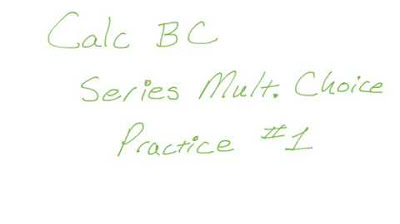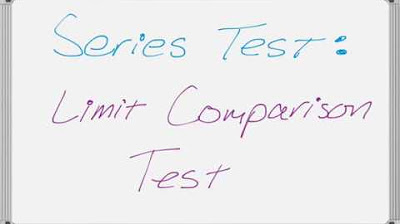Infinite Series Multiple Choice Practice for Calc BC (Part 2)
TLDRThe video script is a part of a series focused on preparing for the AP Calculus BC exam or Calc Two practice problems. The presenter tackles multiple-choice questions regarding the convergence of various mathematical series, including geometric and p-series. The summary of the video involves the analysis of several series to determine if they converge or diverge. Techniques such as the limit comparison test, ratio test, and integral test are mentioned, with a focus on recognizing dominant terms and applying the appropriate tests. The presenter emphasizes the importance of understanding the tests and applying them correctly to succeed in the exam. The video is designed for viewers who are already familiar with the material and are seeking practice in applying these tests to multiple-choice questions.
Takeaways
- 📚 The video is part of a series focusing on multiple-choice questions to prepare for the AP Calculus BC exam or general calculus practice.
- 🔢 The presenter plans to solve nine problems, focusing on series convergence, involving geometric and p-series, as well as other types of series.
- ✅ For problem one, the series involving the absolute value of sine of n over n squared converges by comparison to the convergent p-series of 1/n^2.
- 📈 The second problem is a geometric series with r = 1/e, which converges since the common ratio r is less than one.
- ❌ The third problem is not a straightforward geometric or p-series, and upon closer inspection, it diverges when compared to 1/n, which is a divergent series.
- 🤔 The presenter emphasizes the importance of focusing on dominant terms when analyzing the convergence of a series and not getting misled by less significant terms.
- 📉 For series involving factorials or powers of n, the ratio test can be a useful method to determine convergence, as shown in problem two.
- 🧮 The integral test is mentioned as a method to determine the divergence of a series, particularly when dealing with functions like the natural logarithm.
- 📌 The nth term test is a quick way to check for divergence by examining if the limit of the series' terms as n approaches infinity is non-zero.
- 📈📉 The presenter discusses strategies for multiple-choice questions, recommending to first mark the most likely answer and return to it if time allows for detailed work.
- ⚖️ The final problem involves finding the range of values for p that make both a p-series and a geometric series converge, which requires understanding the conditions for their convergence.
Q & A
What is the main topic of the video?
-The video is focused on solving multiple-choice calculus problems, specifically related to series convergence for AP Calculus BC exam preparation or general calculus practice.
Why does the speaker rewrite the series in the second problem?
-The speaker rewrites the series to make it resemble a geometric series, which is easier to analyze for convergence using standard tests.
What test does the speaker use to determine the convergence of the first series in the video?
-The speaker uses the comparison test by comparing the absolute value of sine of n over n squared to 1 over n squared, which is a convergent p-series with p=2.
What is the strategy for analyzing the third series in the video?
-The speaker focuses on the dominant terms of the series by ignoring the constant terms and comparing it to 1 over n, which is known to diverge.
Why does the speaker believe the third series does not converge?
-The speaker believes the third series does not converge because, by focusing on the dominant terms, it simplifies to 1 over n, which is a divergent series.
What is the significance of the ratio of e to pi in the third convergent series?
-The ratio of e to pi is significant because it is less than 1, which means the series is a convergent geometric series.
What is the general approach the speaker uses for the series where n is raised to the power of 2p + n?
-The speaker initially ignores the 'n' term and focuses on 'n to the power of 2p' as the dominant term, then uses the p-series test to determine divergence.
How does the speaker decide the values of p for which the series 1/n^(2p+n) diverges?
-The speaker decides that the series diverges for p values less than or equal to 1/2, by considering the dominant term n to the power of 2p and applying the p-series convergence criterion.
What test does the speaker use to analyze the convergence of the series with natural logarithm in the denominator?
-The speaker uses the integral test to analyze the convergence of the series with natural logarithm in the denominator.
Why does the speaker believe the series with natural logarithm in the denominator diverges?
-The speaker believes the series diverges because the integral test shows that the integral of the series from 2 to infinity of the function converges to infinity, indicating the series also diverges.
What is the sum of the series if the partial sums are given as -1 to the power of (n+1) for n greater than or equal to 1?
-The sum of the series does not exist because the sequence of partial sums does not settle to a finite value; it oscillates between -1 and 1, indicating the series diverges.
For which values of p do both the p-series and the geometric series converge?
-Both the p-series and the geometric series converge when p is greater than 1/2 (for the p-series) and the absolute value of p is less than 2 (for the geometric series). The common values of p that satisfy both conditions are in the range (1/2, 2).
Outlines
📚 Series Convergence in AP Calculus BC: An Overview
This paragraph introduces the video's focus on series convergence, specifically for AP Calculus BC or general calculus practice. The speaker plans to tackle nine problems, starting with determining which of the given series converge. The discussion covers different types of series, including geometric and p-series, and uses comparison tests to establish convergence, such as the absolute value of sine over n squared and a comparison of n plus 2 over n squared plus n to 1/n.
🔍 Deep Dive into Series Convergence with Practice Problems
The second paragraph delves into solving multiple-choice questions regarding series convergence. It discusses the use of the ratio test and the importance of recognizing geometric series. The speaker also addresses common mistakes made when answering multiple-choice questions and the tendency to assume series convergence. The paragraph includes solving problems involving factorials, e and pi comparisons, and the application of the integral test to determine divergence.
🧮 Advanced Series Analysis and Problem-Solving Strategies
In this paragraph, the focus shifts to more complex series analysis. The speaker discusses strategies for determining the values of p for which a series diverges, emphasizing the importance of looking at dominant terms and using limit comparison tests. The paragraph includes solving problems involving series with factorials, natural logarithms, and the application of the nth term test for divergence, highlighting the need for careful reading and understanding of the problem at hand.
📉 Series Summation and Divergence: Identifying Key Values
The final paragraph deals with identifying values of p for which both a p-series and a geometric series converge. It outlines the conditions for convergence of p-series and geometric series and combines these to find the range of p values that satisfy both conditions. The speaker also touches on the concept of series summation, explaining that if the limit of partial sums does not exist, the series diverges, as demonstrated through an example involving negative one raised to the power of n plus one.
Mindmap
Keywords
💡Convergence
💡Geometric Series
💡p-Series
💡Limit Comparison Test
💡Integral Test
💡nth Term Test for Divergence
💡Factorial
💡Ratio Test
💡Harmonic Series
💡Dominant Terms
💡Multiple Choice Questions
Highlights
The video is a continuation of a series focused on multiple-choice questions for AP Calculus BC exam preparation.
The presenter plans to solve nine problems, focusing on series convergence, involving geometric and p-series.
For the first problem, the series involving the absolute value of sine of n over n squared is shown to converge by comparison to 1/n^2.
The second problem is a geometric series that converges because its common ratio (1/e) is less than one.
The third problem is analyzed by focusing on dominant terms, leading to the conclusion that the series does not converge.
The presenter emphasizes the importance of not misinterpreting questions about convergence and divergence.
A ratio test is suggested for the second problem, which is expected to converge due to the factorial term's location.
The third problem in the next set is identified as a geometric series with a ratio of e/pi, which is less than one, indicating convergence.
The presenter discusses the values of p for which the series 1/n^(2p+n) diverges, focusing on the dominant term n^(2p).
The importance of considering all terms in a series, not just the dominant ones, is highlighted to avoid incorrect assumptions.
For problem 13, the first series is a p-series that converges, the second is a geometric series that converges, and the third is suspected to diverge.
The integral test is used to confirm the divergence of the third series in problem 13, as the integral of 1/ln(x) diverges.
In problem 14, the series 3n/(n^2 + 2) is analyzed, and the presenter uses limit comparison to determine convergence.
The presenter advises on the strategy for multiple-choice questions, suggesting quick decision-making and revisiting if time allows.
For the series n/(n^p + 1), the presenter simplifies to a p-series and determines that p must be greater than 2 for convergence.
In the series involving sine of (2/π)^n, the presenter clarifies that the absolute value of sine is always less than one, leading to convergence, not divergence.
The video concludes with a problem involving two series, a p-series and a geometric series, and the presenter finds the common range for p that ensures convergence of both.
The presenter emphasizes the importance of understanding the concepts behind p-series and geometric series for successful problem-solving.
Transcripts
Browse More Related Video

Infinite Series Multiple Choice Practice for Calc BC (Part 4)

Infinite Series Multiple Choice Practice for Calc BC (Part 6)

AP Calc BC Series Review Multiple Choice Practice

Series Tests - Limit Comparison Test

Infinite Series Multiple Choice Practice for Calc BC (Part 5)

AP Calculus BC 2008 Multiple Choice (no calculator) - questions 1 - 28
5.0 / 5 (0 votes)
Thanks for rating: